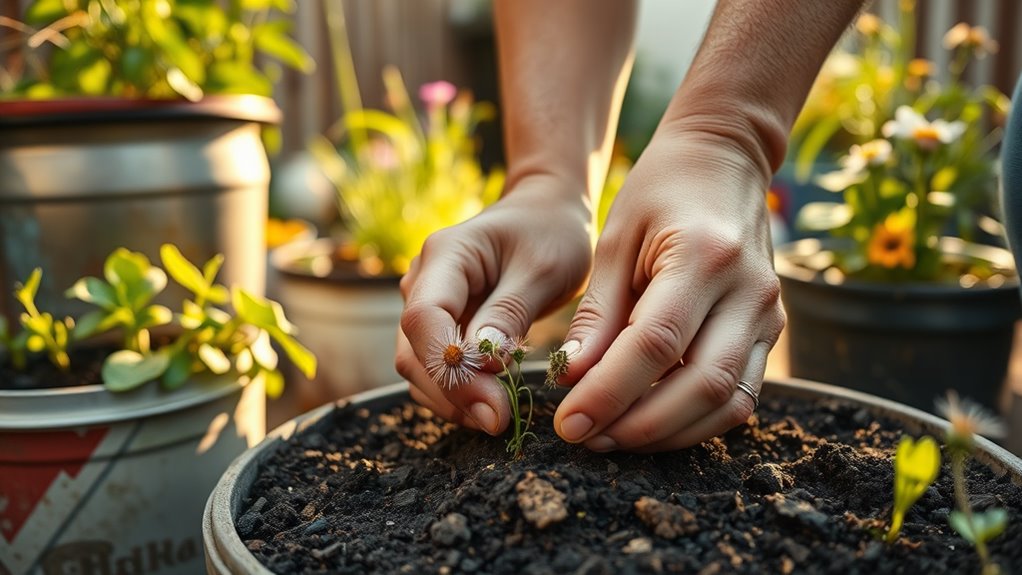Start a Flower Garden Without Spending a Dime – Here’s How
You can start your flower garden for free by gathering seeds from friends’ blooms or local swaps. Repurpose old yogurt cups as planters and use sticks as DIY tools. Create nutrient-rich compost from kitchen scraps and yard leaves, then capture rainwater in barrels for easy watering. Propagate new flowers from stem cuttings and design your layout based on sunlight and shade. Keep exploring these tips to watch your garden flourish.
Gather Free Seeds and Plants
Gathering free seeds and plants is a smart first step in starting your flower garden without spending a dime.
For budget flower gardening, you collect seeds from friends’ mature blooms or join local swaps, where enthusiasts share extras.
Scout community events for giveaways, and ask neighbors for divisions from their perennials.
This way, you’re building a diverse, cost-free collection that thrives with minimal effort, ensuring a vibrant garden starts simply. Additionally, by using cost-effective practices, you can maximize your gardening experience while minimizing expenses.
Repurpose Household Items
You can repurpose everyday household items to kickstart your flower garden without spending a dime.
Grab those old containers, such as yogurt cups or tin cans, and turn them into practical planters for your seeds and starts.
Use items like sticks or bottle caps to make your own DIY tools that help with digging or weeding efficiently. Additionally, consider using these repurposed items for container gardening to optimize your space and resources effectively.
Reuse Old Containers
Repurposing old containers breathes new life into everyday items, turning them into cost-free planters for your flower garden.
You’ll spot potential in plastic bottles, tin cans, or worn buckets—clean them first to eliminate dirt and residues.
Add drainage holes using a tool you already own, ensuring excess water escapes and roots stay healthy.
This simple swap saves money while boosting your garden’s charm.
Make DIY Tools
How might you transform everyday household items into practical DIY tools for your flower garden? You’ll repurpose them easily to save money and get creative. For instance, turn an old spoon into a digger or a plastic bottle into a watering can.
| Household Item | DIY Tool Use |
|---|---|
| Old Spoon | Dig small holes |
| Plastic Bottle | Create a watering can |
| Fork | Loosen compacted soil |
| Cloth Scraps | Tie up climbing plants |
Create Natural Compost
Creating natural compost is an essential step in building a free flower garden, turning everyday waste into nutrient-packed soil enhancer.
To begin, gather kitchen scraps like vegetable peels and yard debris such as leaves.
Layer greens and browns in a pile for balance, then turn it weekly to promote decomposition. Composting at home can be done in small spaces, making it accessible for everyone.
You’ll produce rich, free fertilizer in a few months, enhancing your soil’s fertility naturally.
Use Rainwater for Watering
After building your compost to enrich the soil, you’ll find that collecting rainwater offers a cost-free way to keep your flower garden hydrated.
It’s simple and eco-friendly, using what nature provides.
- Position barrels under downspouts to capture runoff easily.
- Use clean containers to avoid contaminants and guarantee plant safety.
- Filter through a mesh to remove debris before use.
- Water early in the day to minimize evaporation losses.
- Store in shaded areas to prevent algae growth and maintain quality.
Additionally, utilizing rainwater helps conserve water while providing essential hydration for your plants.
Propagate Flowers From Cuttings
Propagating flowers from cuttings lets you expand your garden at no cost by turning stem pieces from existing plants into new ones.
You’ll select a healthy stem, cut it at a 45-degree angle below a node, and dip it in water or natural honey for rooting.
Place it in moist soil or a jar of water in indirect sunlight.
Keep the cutting humid and wait for roots to develop, then transplant carefully.
This method multiplies your favorites effortlessly. Additionally, many beautiful flowers for gardens can be easily propagated this way, enhancing your garden’s diversity and beauty.
Design a Garden Layout on a Budget
Designing your garden layout doesn’t have to cost a dime; you can sketch a simple plan using free tools like graph paper or apps on your phone.
This helps you optimize space while considering sunlight, soil, and plant needs for a thriving garden.
- Assess your site’s sunlight and shade to position flowers effectively.
- Group plants by water requirements to conserve resources.
- Incorporate natural paths using existing ground cover.
- Balance heights and colors for visual appeal.
- Maximize space with vertical elements like trellises from scraps.

